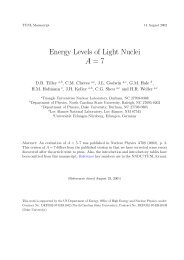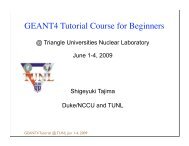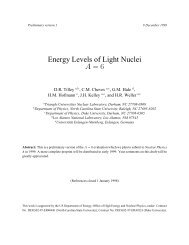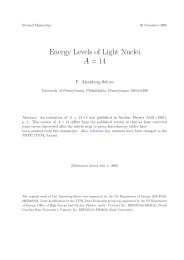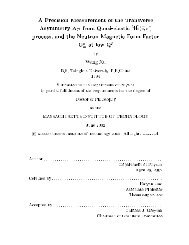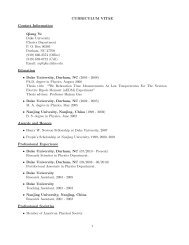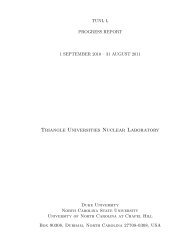Introduction to Nuclear reactions
Introduction to Nuclear reactions
Introduction to Nuclear reactions
You also want an ePaper? Increase the reach of your titles
YUMPU automatically turns print PDFs into web optimized ePapers that Google loves.
<strong>Introduction</strong> <strong>to</strong><br />
<strong>Nuclear</strong> <strong>reactions</strong><br />
G.J. Weisel<br />
Penn State Al<strong>to</strong>ona<br />
June 12, 2006<br />
Hodgson, Gadioli, and Erba, Introduc<strong>to</strong>ry <strong>Nuclear</strong> Physics (1997)<br />
N.A. Jelley, Fundamentals of <strong>Nuclear</strong> Physics (1990)<br />
K.S. Krane, Introduc<strong>to</strong>ry <strong>Nuclear</strong> Physics (1988)<br />
G.R. Satchler <strong>Introduction</strong> <strong>to</strong> <strong>Nuclear</strong> Reactions (1990)
Notation for scattering experiment<br />
a<br />
X<br />
b<br />
Y<br />
a + X --> b + Y<br />
X(a,b)Y<br />
incoming particle (from source)<br />
target nucleus<br />
outgoing particle (detected)<br />
residual nucleus
Examples of nuclear <strong>reactions</strong>:<br />
Fission<br />
Fusion<br />
Elastic<br />
Inelastic<br />
Pickup<br />
Stripping<br />
Capture<br />
Pho<strong>to</strong>disintegration<br />
(n,2nγ) <strong>reactions</strong><br />
n + 235 U --> 2n + 93 Rb + 141 Cs<br />
3 H(d,n) 4 He<br />
208 Pb(n,n) 208 Pb<br />
208<br />
Pb(n,n') 208 Pb<br />
208 Pb(p,d) 207 Pb<br />
208<br />
Pb(d,p) 209 Pb<br />
3<br />
He(α,γ) 7 Be<br />
3 He(γ,p) 2 H<br />
179<br />
Hf(n,2nγ) 178 Hf
Scattering experiment is done in lab frame<br />
but data is reported in center of mass frame<br />
Lab system<br />
Classically:<br />
v cm<br />
= (m a<br />
v a<br />
)/(m a<br />
+ m x<br />
)<br />
Center of Mass system
Cross Section, σ<br />
σ = “effective area” of a target nucleus for a certain reaction<br />
Units are barns, b = 10 -28 m 2 (or mb = 10 -31 m 2 )<br />
The <strong>to</strong>tal effective area of all nuclei in target = σ (nAt)<br />
Rate of reaction<br />
= (incoming beam rate) x (<strong>to</strong>tal effective area) / (area of the target)<br />
R reaction<br />
= N i σ (nAt)/A = N i<br />
σ nt
Differential cross section, σ(θ)<br />
Α cross section per solid angle, σ(θ), or dσ/dΩ, with units of mb/sr<br />
∆Ω = solid angle of detec<strong>to</strong>r (sr)<br />
Total steradians in a sphere = 4π<br />
∆A = area of detec<strong>to</strong>r face<br />
∆Ω = 4π ∆A/(4πr 2 ) = ∆A/r 2<br />
R detec<strong>to</strong>r<br />
= N i<br />
[σ(θ) ∆Ω] (nAt)/A = N i<br />
[σ(θ) ∆Ω] nt
Q Value<br />
X(a,b)Y<br />
Define Q value as a “mass difference”:<br />
Q = (m Y<br />
c 2 + m b<br />
c 2 ) - (m X<br />
c 2 + m a<br />
c 2 )<br />
From energy conservation (target X initially at rest):<br />
m X<br />
c 2 + m a<br />
c 2 + K a<br />
= m Y<br />
c 2 + m b<br />
c 2 + K Y<br />
+ K b<br />
Therefore, we also can think of Q as change in K <strong>to</strong>tal<br />
:<br />
Q = (K Y<br />
+ K b<br />
) - K a
For positive Q values, energy is released (exothermic)<br />
Fission<br />
Fusion<br />
n + 235 U --> 2n + 93 Rb + 141 Cs<br />
Q = 181 MeV<br />
3 H(d,n) 4 He<br />
Q = 17.6 MeV<br />
For negative Q values, reaction threshold = -Q (endothermic)<br />
Pickup<br />
(n,2n)<br />
208 Pb(p,d) 207 Pb<br />
Threshold = 5.17 MeV<br />
179<br />
Hf(n,2n) 180 Hf<br />
Threshold = 6.09 MeV
Rutherford Scattering<br />
Scattering from Coulomb field<br />
Differential cross section, σ R<br />
(θ),<br />
is forward peaked.<br />
Rutherford worked on<br />
197 Au(α,α) 197 Au.<br />
Similar results for large enough<br />
charge or low enough energies.<br />
208<br />
Pb( 16 O, 16 O) 208 Pb
<strong>Nuclear</strong> elastic scattering<br />
Using higher-energy and/or smaller-charged projectiles,<br />
we see nuclear scattering.<br />
Divide the measured differential cross section by the theoretical<br />
Rutherford cross section.<br />
σ(θ)/σ R<br />
(θ) for (p,p) elastic scattering<br />
shows diffraction-like pattern!<br />
Incoming “wave” of pro<strong>to</strong>ns of<br />
de Broglie wavelength λ = h/p<br />
At E p<br />
= 10 MeV, λ = 9 fm
¡<br />
£<br />
Partial Wave Analysis<br />
of nuclear scattering<br />
Represent incoming particle beam as a plane wave<br />
with de Broglie wavelength λ = h/p.<br />
Assume solution <strong>to</strong> Schroedinger equation depends only on r and θ.<br />
For a central force, assume the form of the solution at infinity is:<br />
(Solution) = (Plane wave) + (Scattered spherical wave)<br />
(Scattered wave) = λ/(4πi)<br />
Σ (2<br />
+1) P<br />
(cosθ) (exp(2iδ<br />
) – 1),<br />
where P<br />
¢(cosθ) are “Legendre polynomials.”<br />
The δ<br />
¢, or “phase shifts,” are determined via curve fitting or modeling.<br />
The lower the energy, the fewer<br />
values are needed.
Direct vs. Compound nuclear <strong>reactions</strong><br />
Direct: Incoming particle either<br />
scatters elastically (shape elastic) or<br />
only “grazes” target, interacting with<br />
nucleons at surface.<br />
Interaction time around 10 -22 s.<br />
Compound: A two-step process.<br />
First, incoming particle enters target<br />
and forms a compound nucleus.<br />
Then, compound nucleus ejects<br />
particle(s).<br />
Interaction time around 10 -16 s.<br />
Direct scattering “remembers”<br />
beam direction; its differential<br />
cross section is forward peaked
Compound Reactions<br />
a + X --> C* --> b + Y<br />
Independence hypothesis:<br />
The decaying compound nucleus, C*<br />
has no “memory” of how it was formed.<br />
Excitation functions; graphs of σ vs.<br />
incoming particle energy.<br />
dotted line: 63 Cu(p,n) 63 Zn<br />
63<br />
Cu(p,2n) 62 Zn<br />
63 Cu(p,pn) 62 Cu<br />
60<br />
solid line: Ni(α,n) 63 Zn<br />
60<br />
Ni(α,2n) 62 Zn<br />
60 Ni(α,pn) 62 Cu<br />
For both sets of experiments,<br />
we see the same resonances,<br />
reflecting states of the<br />
compound nucleus 64 Zn<br />
(“nuclear structure”)
Individual resonances of compound nucleus<br />
R-matrix (reaction matrix) analysis<br />
Match internal and external waves at<br />
boundary of nuclear potential <strong>to</strong> determine<br />
angular momentum and parity<br />
of excited states of compound nucleus.<br />
p + 26 Mg --> 27 Al --> p + 26 Mg<br />
Excitation function of σ(θ) shows<br />
resonances for states in 27 Al
(n,n'γ) and (n,2nγ) <strong>reactions</strong><br />
Neutron is captured <strong>to</strong> form compound nucleus. Then, the compound<br />
nucleus ejects neutron(s), leaving residual nucleus.<br />
Measure the energy spectrum of the gammas <strong>to</strong> identify excited states<br />
of the residual nucleus and determine the cross sections.<br />
Example:<br />
179<br />
Hf(n,2nγ) 178 Hf<br />
Reactions of<br />
interest <strong>to</strong><br />
national security<br />
(bomb design)
Direct Reaction<br />
Optical model of nuclear elastic scattering<br />
Analogy between optical scattering<br />
(complex index of refraction) and nuclear<br />
scattering (complex nuclear potential)<br />
120<br />
Sn (n,n) 120 Sn<br />
Note diffraction-like patterns<br />
The imaginary part of the nuclear<br />
potential acts as a sort of “sink hole”<br />
for all nuclear <strong>reactions</strong>. It gives σ R<br />
predictions that are smooth with energy.<br />
Therefore, the optical model cannot<br />
see nuclear structure. It is best used<br />
when the compound-nucleus channels<br />
form a continuum of <strong>reactions</strong> (above<br />
10 MeV or so).
<strong>Nuclear</strong> Optical Model Potential<br />
V(E) = (V v<br />
(E) + iW v<br />
(E)) + (V s<br />
(r) + iW s<br />
(E))<br />
volume surface<br />
Real terms, V v<br />
and V s<br />
, model elastic scattering<br />
Imaginary terms, W v<br />
and W s<br />
, are the “sink hole” for <strong>reactions</strong><br />
At relatively high energies<br />
(above 40 MeV), W v<br />
dominates<br />
At relatively low energies , W s<br />
is also important (projectiles do<br />
not penetrate nucleus as much).
Direct reaction<br />
Stripping Reaction<br />
Incoming projectile leaves a particle in well-defined state of the residual<br />
nucleus. From σ(θ) of scattered pro<strong>to</strong>ns, deduce properties of singleparticle<br />
states of residual nucleus.<br />
“Dis<strong>to</strong>rted Wave Born approximation” (DWBA):<br />
Approximate the incoming and outgoing waves with optical model<br />
representations, from analysis of elastic scattering.<br />
The “transition amplitude” is<br />
T = ∫[outgoing wave] F(r) [incoming wave] dv,<br />
where F(r), the “form fac<strong>to</strong>r,” contains the structure information.<br />
Differential cross section, σ(θ), is proportional <strong>to</strong> |T| 2 . Modify F(r)<br />
until it reproduces σ(θ)for each state of the residual nucleus.
Example of stripping reaction: 90 Zr(d,p) 91 Zr<br />
Spectrum of pro<strong>to</strong>ns (for each angle)<br />
show peaks related <strong>to</strong> states of 91 Zr<br />
Data is sorted by gating counts<br />
for each pro<strong>to</strong>n peak when<br />
graphing differential cross sections.<br />
Deduce single-particle structure<br />
information from the σ(θ) curves.
Reactions involving gamma rays<br />
Radiative Capture<br />
Target absorbs incident particle and<br />
at the same time a gamma ray is released<br />
Pho<strong>to</strong>disintegration<br />
Incident gamma ray breaks up target<br />
Inverse reaction <strong>to</strong> radiative capture<br />
Example:<br />
H(n,γ) 2 H<br />
Deuteron formation<br />
Q = 2.225 MeV (exothermic)<br />
2<br />
H(γ,n)p Deuteron breakup<br />
Threshold = 2.225 MeV (endothermic)
Radiative Capture<br />
Deduce electromagnetic transitions:<br />
from scattering state <strong>to</strong> state of residual<br />
nucleus. Many such <strong>reactions</strong> are important<br />
in nucleosynthesis. “<strong>Nuclear</strong> astrophysics”<br />
At low energies (near Coulomb barrier),<br />
it is convenient <strong>to</strong> multiply the cross<br />
section by the energy:<br />
S fac<strong>to</strong>r = σ E e -2πη .<br />
(The exponential is the “penetration fac<strong>to</strong>r.”)<br />
Example: 2 H(d,γ) 4 He<br />
Excitation function for S fac<strong>to</strong>r fit<br />
using two E2 transitions<br />
(electric transitions with ∆L = 2)
Pho<strong>to</strong>disintegation<br />
Example: 3 He(γ,p)d<br />
Excitation function<br />
for <strong>to</strong>tal cross section, σ<br />
Model incoming channel with electromagnetic interaction.<br />
For outgoing channel, do a three-body (Faddeev) calculation,<br />
based on a model of the NN interaction (Bonn, AV18, etc.)<br />
Precision σ data places constraints on the three-body computations<br />
and on the NN models.


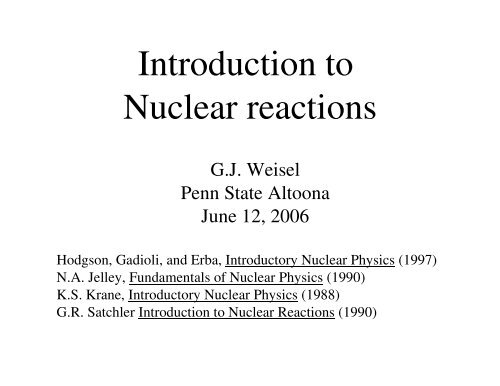
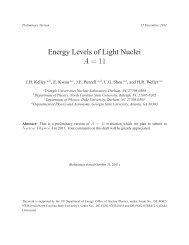

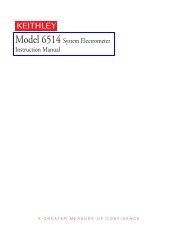
![TUNLXXXIV.tex typeset [1] - Triangle Universities Nuclear Laboratory](https://img.yumpu.com/47618358/1/190x245/tunlxxxivtex-typeset-1-triangle-universities-nuclear-laboratory.jpg?quality=85)
